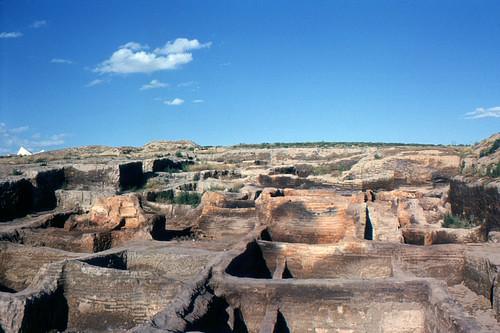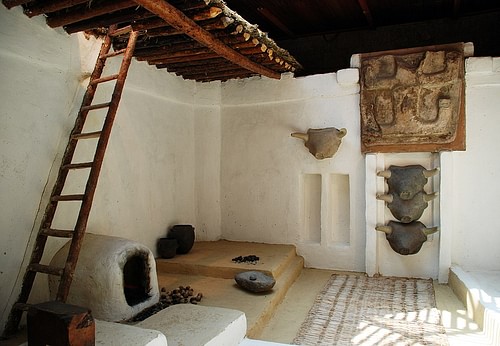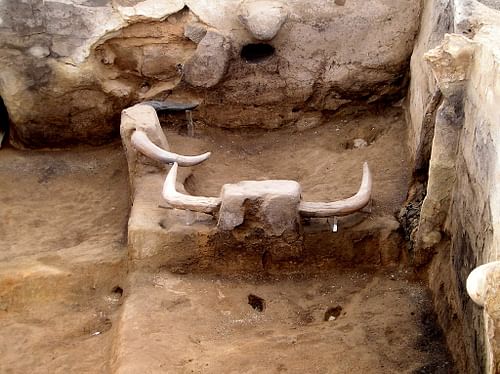
Ҫatalhöyük is one of the largest Neolithic settlements ever discovered. Built more than 9000 years ago in modern Konya Plain, central Turkey, it is known in archaeology as a proto-city, a link between the cave-dwellings of prehistoric hunter-gatherers and the early urban constructions. This is where communities began to grow crops and herd animals in preplanned and systematic ways for the first time in history.
The inhabitants of Çatalhöyük formed an egalitarian society. Bone analyses of the buried skeletons in Çatalhöyük indicate equal diets and equal workloads for men and women. Large assemblages of bone artefacts, rare cutting tools, arrowheads, and votive gifts made of obsidian – including the oldest 'glass-mirror' ever found – as well as the world's oldest pieces of textile are among the most significant finds in Çatalhöyük. Located up north of the Fertile Crescent and Mesopotamia, Çatalhöyük extends the Near Eastern cradle of farming, economy, architecture, and industry both geographically and historically.
The first 'ant-nest' mound in Ҫatalhöyük appeared sometime between 7400 and 7100 BCE in connection with several important developments of human life: agriculture; animal domestication; social differentiation; craftmanship (pottery and metallurgy); and religion practised at a private level. The Ҫatalhöyük site consists of two mounds at the east and west of an ancient river, a landscape that reflects the meaning of its name, "fork-tumulus". The river, perhaps a distant branch of Çarşamba river further north, is now covered with fields but was then the main source of water for the arable plain stretched through and all around Ҫatalhöyük. It is very likely that drying out of this river played a key part in the abandonment of the site c. 5600 BCE.
Discovery & Archaeological Importance
In the field of archaeology, the name of Ҫatalhöyük is primarily linked with James Mellaart, an English archaeologist who first discovered and then began to excavate the site between 1961 and 1964. His finds, which dramatically changed the modern views of life before the dawn of civilization, included the very first mudbrick houses, constructed a few hundred years later than the earliest mudbricks retrieved so far from before 7500 BCE in Syria and Anatolia. Many of these houses were decorated with brightly-coloured, vivid wall paintings of wild animals, birds, and human figures, some of them headless. Nude female figurines were also found in Ҫatalhöyük and interpreted as the most ancient representations of the Mother Goddess worshipped widely across Anatolia and beyond in later periods.
Mellaart's work on Ҫatalhöyük abruptly came to an end, and after an odd 30-year break, Ian Hodder, a student of Mellaart at the University of London, was inspired by him to resume the excavations. Hodder revived the Ҫatalhöyük archaeological digs in 1993, and used his finds, including grave goods and tools, to shape his groundbreaking postprocessual methodology, which helps us understand and reconstruct people's ways of living through examination of material finds against the specific time, place, and cultural context of their retrieval. Ҫatalhöyük, thus, introduced seminal changes in both our picture of the past and the methods available to us to reconstruct this picture in a meaningful way.
Neolithic Revolution
Neolithic settlements mark the transition from nomadic to settled, agricultural life. Agriculture in the Fertile Crescent & Mesopotamia had already begun to develop by 9000 BCE, when tribal groups of hunter-gatherers discovered the earliest methods of growing wheat, barley, and, later, some legumes including peas and lentils. This control over food production meant organisation, systematisation, and technological improvements. It is presumed that the immobility required for the completion of farming tasks, followed by preservation, distribution, and consumption of their produce, finally put an end to 40,000 years of nomadic life. Some scholars, however, tend to flip this argument, claiming that the construction of stronger and more permanent shelters was an effect of the persistent global warming after the Younger Dryas, a short return to the Ice Age around 11000 BCE, and that the formation of warm and wet locations to settle in paved the way for the domestication of plants and animals. Either way, this new way of life in the Early Neolithic era ushered in a social, economic, and cultural change, the Agricultural Revolution.
Archaeological finds establish a strong correspondence between the early agrarian societies and some significant cultural developments. The monumental megaliths in Göbekli Tepe, the earliest Neolithic site found so far, with their circular setting and the multi-meaning symbolism of their sculpted decorations suggest ancient ritual gatherings. More to the economic side, parts of the site were evidently used for communal storage. However, traces of daily life have not yet been spotted there. These appear much later in the housing and urban architectures of the Pre-Pottery Neolithic sites such as Tell al-Sultan in Jericho (c. 8500-7500 BCE), Aşikli Höyük (c. 8200-7400 BCE), and Çatalhöyük (c. 7500-5600 BCE).
Çatalhöyük is particularly important because it gives away a wide range of information about its inhabitants and their lifestyle. The huge number of burials found there – both under the house floors and in the East Mound that, in the later periods, was deserted to be used exclusively as a necropolis – suggests that Çatalhöyük had a population between 3500 to 8000, an extraordinary number for Neolithic groups of settlers. The departure from the early village life in Çatalhöyük is reflected in a shift from communal to individual rituals and burials and in the private storage places found in individual dwellings. These dwellings were initially styled in a way to form a massive compound of cavities rather like an ant-nest: grottos carved into a big mound to divide its interior space into individual rooms. From c. 6000 BCE onwards, generations of permanent residents of each room began to reshape their house into honeycomb-cell room-flats.
Square-shaped room-flats made of mudbricks with plastered walls, beaten earth floors, and wooden timbers to support the roof were piled up on top of each other, row by row, so that the roofs of lower houses also served as courtyards and pathways for their upper levels. The house complexes in Çatalhöyük, thus, preserved the overall shape of a mound, which eventually rose up to 21 meters in height. There were no streets or passageways, instead, every rooftop had a big opening, usually above the oven-hearth of the room in its southern side, to let out the smoke, take in the sunlight and fresh air, and allow people to move in and out. Members of a household would gather in their room-flat to eat, sleep, practise rituals, and do other daily activities.
Society & Economy
Çatalhöyük features an egalitarian model of society in many respects. All houses are similar in size, none of them looks significantly larger or contains bigger and better hearths and storage places, or includes more or better tools and grave goods than the rest. There is no sign of public buildings or ceremonial centres. The similarity of the houses, their decorations, and their storage places is taken by scholars as solid evidence against socio-economic hierarchies: no kings or leaders or groups of elites have been identified yet.

Apart from social equality, we can also observe indications of gender equality in Çatalhöyük. In the absence of written records, we can only assume, based on our own perception of a family, that there were certain familial groups living together, but it is not clear what kind of marital patterns were common among them: monogamous or polygamous; male-centred or female-centred. Most human figures in murals are painted as genderless. Human skeletons retrieved from the graves under the house floors or in the necropolis of Ҫatalhöyük represent both males and females without any striking difference in the quality and quantity of burials.
There is a slight difference in terms of life expectancy between men and women that might be related to childbirth. Otherwise, both genders enjoyed identical diets and had to cope with similar workloads. Working in the fields, tending the animals, household chores, and perhaps even cooking and kitchen work was among the daily tasks for everybody. DNA tests on the remains of children, surprisingly, reveal that the offspring of one family could be placed in a different house to live in, which reminds some scholars of a 'state' programme for raising children of the community on a shared basis.
In the first round of excavations in the 1960s, James Mellaart found a few houses decorated with elaborate wall paintings and bucrania, enormous bull horns installed on the top of short, linear floor-risings to separate a part of the room. Mellaart called these houses 'shrines', believing that they must have been reserved for a rank of the religious elite in the social structure of Çatalhöyük. More careful inspections, along with the use of new technologies available in the 1990s, however, revealed that other houses of Çatalhöyük also have mural decorations hidden under layers of plasters that were used at different times to cover the dirt and soot. Many of the renewed coatings had fresh paintings, while the others were left blank. Although the uncovering of murals in nearly all houses of Çatalhöyük reaffirmed the existence of an egalitarian society at least in terms of wealth and status, Ian Hodder's further excavations in the houses with more enhanced decorations resulted in the finding of extraordinary masses of skeletons and pointed at a degree of religious centrality for these houses.
Art & Religion
The headless human figures appearing in the wall paintings of Ҫatalhöyük have long been a matter of question for scholars. These anthropomorphic, genderless characters, also appearing in the sculpted reliefs on the Göbekli Tepe megaliths, are thought to relate to rituals and religion. Since they are often accompanied by vultures in Çatalhöyük murals, the early interpretations suggested a connection to burial rites: the dead body was left out in an exposed area to be stripped of its flesh by the vultures, and then the clean bones were collected and interred. Such a ritual, however, has no reliable testimony in any of the local cultures.
More recently, Ian Hodder found headless skeletons, whose heads had been removed to be installed near the entrances. These heads, again of both men and women, often belonged to the aged members of the society, suggesting some special reverence for them as holy, sage elders and then ancestors, protectors of the household and community. Since sometimes these heads were returned to the original bodies, it also became apparent that this group of people could have special or even repeated burials.
This interpretation sheds new light on our understanding of The Seated Woman of Çatalhöyük, one of the nude female figurines retrieved from the graves and niches of the site. Characterized by their oversized bellies and buttocks and their big, elongated breasts, these figurines have attracted a variety of labels ranging from goddesses to fertility charms to materializations of ideal femininity. The material support for these hypotheses has been sporadic and often not directly relevant to Çatalhöyük. Age-bound holiness and reverence, however, might be consistent with the physical features of the Çatalhöyük 'goddesses' whose fat and loose limbs can symbolize old and inactive women.
Moreover, the great number of male- and animal figurines found in Çatalhöyük broadens the possibility of the existence of different rites and rituals revolving around worshipping men or their zoomorphic counterparts.








